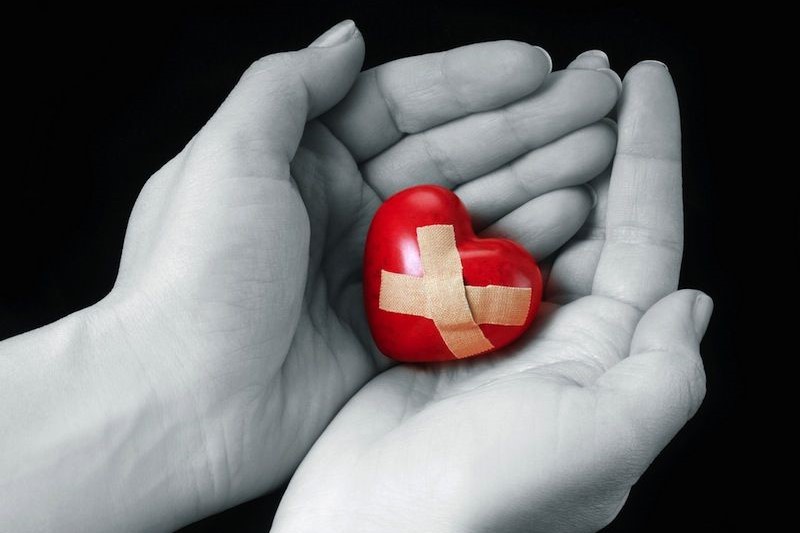
What is takotsubo cardiomyopathy (broken heart syndrome)?
Takotsubo cardiomyopathy, which some people call broken heart syndrome, is a sudden stress-induced heart condition. Although it is not a heart attack, it can cause similar symptoms
The exact cause remains unclear, but takotsubo cardiomyopathy does not indicate underlying heart disease
Doctors may also refer to takotsubo cardiomyopathy as stress cardiomyopathy or apical ballooning.
This condition causes damage to the left ventricle. On an imaging scan, doctors usually notice a ballooning of the ventricle.
A person may report symptoms similar to those of a heart attack, such as chest pain or shortness of breath.
The death rates from this condition and a heart attack are similar.
However, with treatment, most people recover from broken heart syndrome.
Although takotsubo cardiomyopathy most often affects females aged 62–76 years, males with the condition are less likely to have a positive outlook.
The condition commonly occurs immediately after experiencing extreme emotional or physical stress.
Takotsubo cardiomyopathy: What is it?
Researchers first identified takotsubo cardiomyopathy in Japan in 1990.
Doctors now know that it is relatively uncommon, representing only about 1–2% of suspected cases of acute coronary syndrome, which is the term for a range of conditions linked with a sudden reduction in the blood flowing to the heart.
This syndrome causes the left ventricle of the heart to bulge into a balloon shape.
The shape resembles a Japanese fisher’s takotsubo pot, which they use to trap octopuses.
This gave the syndrome its name.
Takotsubo cardiomyopathy starts abruptly and unpredictably, usually following a very stressful event, such as the death of a loved one, a natural disaster, or a physical stress.
It is most common among postmenopausal females.
Some datasuggest that Mediterranean and Asian females are particularly susceptible to the condition.
People with takotsubo cardiomyopathy may seek emergency treatment because of concerns that they are experiencing a heart attack.
However, takotsubo cardiomyopathy is different because it can occur in the absence of blocked coronary arteries.
Takotsubo cardiomyopathy can be fatal.
Its cardiogenic shock and death rates are similar to those of other acute coronary syndromes, such as heart attack.
Takotsubo cardiomyopathy vs. heart attack
It is not possible to self-diagnose takotsubo cardiomyopathy or to distinguish it from a heart attack based on the symptoms alone.
However, there are important distinctions, including:
- No signs of heart disease: Although it is possible for people who experience takotsubo cardiomyopathy to have underlying heart disease, the underlying heart disease does not cause the symptoms. Upon examination, people with this syndrome do not show typical heart attack signs and often have no heart disease at all.
- Better recovery: Heart attack recovery can be long and intense, and a person may still have serious underlying heart disease. In comparison, a 2020 paper estimates that 96% of people with takotsubo cardiomyopathy fully recover.
- Lower recurrence rates: People who have a heart attack typically have underlying heart disease, which increases their risk of having another heart attack. Takotsubo cardiomyopathy has a relatively low recurrence rate of 2–4% per year.
- Temporary condition: Takotsubo cardiomyopathy is a temporary condition that usually resolves on its own, although some people may experience long-term heart complications. A heart attack, in contrast, happens because of underlying heart disease. An untreated heart attack can be fatal.
Causes of takotsubo cardiomyopathy
Researchers do not know the exact cause of takotsubo cardiomyopathy.
However, many speculate that at times of intense stress, the release of stress-related hormones such as epinephrine causes blood vessel spasms that disrupt heart function.
This causes the ventricles to malfunction and the left ventricle to balloon.
When the ventricle balloons, the heart muscle cannot pump blood as effectively.
Although this typically resolves on its own, prolonged ballooning of the ventricle can cause serious complications.
About 20% of people develop congestive heart failure.
As the condition is significantly more common among females than among males, researchers have considered the role of hormones such as estrogen.
They believe that low estrogen levels might play a role.
The risk factors for this condition are environmental, suggesting a complex interaction between the environment and biological factors such as hormone levels.
Moreover, the same event at different times or in different circumstances may not trigger symptoms again.
Risk factors include:
- domestic abuse
- the death of a relative
- natural disasters
- trauma
- accident
- major financial loss
- arguments
- a recent diagnosis of a serious illness
- using stimulant drugs, such as amphetamines or cocaine
Some instances of takotsubo cardiomyopathy have occurred after positive events, such as winning the lottery or having a surprise party.
COVID-19
A 2020 study suggests that the COVID-19 pandemic and forms of stress related to it may be linked to an increased incidence of stress cardiomyopathy.
The study included 1,914 individuals who reported to two hospitals in Ohio with acute coronary syndrome across five different periods.
One period was during the pandemic — March 1 to April 30, 2020 — and four were in the years leading up to it.
The researchers noted a 7.8% incidence of stress cardiomyopathy during the pandemic period, compared with 1.5% to 1.8% in the periods before the pandemic.
Symptoms of takotsubo cardiomyopathy
The symptoms of takotsubo cardiomyopathy are similar to those of a heart attack.
They include:
- irregular heartbeat
- dizziness or fainting
- chest pain
- shortness of breath
- stroke-like symptoms, such as confusion, numbness on one side of the body, or facial drooping
It is not possible to diagnose takotsubo cardiomyopathy based on the symptoms alone.
A person should always treat chest pain as an emergency.
Diagnosis
Doctors will approach the diagnosis of takotsubo cardiomyopathy in a similar way to diagnosing a heart attack.
Some tests that they might recommend include:
- an EKG to view electrical activity in the heart
- blood tests to look for enzymes associated with heart attacks
- an angiogram to view the blood vessels of the heart
- an echocardiogram to get an image of the heart
- an MRI scan of the heart
A doctor may diagnose takotsubo cardiomyopathy based on the following criteria:
- a recent stressful event
- either no obstructive coronary disease or no evidence of recent rupture of plague
- slight elevation in the chemical troponin
- EKG abnormalities
- no signs of myocarditis, which is heart inflammation
- ballooning in the left ventricle
Treatment
A person with takotsubo cardiomyopathy needs supportive care in a hospital setting until the left ventricle recovers.
They will often need to stay in hospital for several days.
Full recovery can take 3–4 weeks or longer.
Medications that doctors commonly use to treat takotsubo cardiomyopathy include beta-blockers and angiotensin converting enzyme (ACE) inhibitor drugs.
These drugs promote heart muscle recovery.
A doctor may sometimes recommend blood thinning drugs to prevent a stroke, especially if a person has a heart arrhythmia or is at risk of developing one.
A person may need to take anti-anxiety or beta-blocker medication for an extended period to help control the release of stress hormones.
It is also important to alleviate or manage the stress that may have played a role in triggering the disorder.
Complications of takotsubo cardiomyopathy
Takotsubo cardiomyopathy itself is a mostly benign condition. However, it increases a person’s risk of developing other conditions, including:
- heart failure
- severe heart arrhythmias
- blood clots
- heart valve problems
- cardiogenic shock
Close follow-up care with a cardiologist is important to monitor the heart.
Doctors do not know the long-term effects of takotsubo cardiomyopathy
However, researchers do know that underlying heart disease does not cause this syndrome. Instead, they believe that stress causes an acute crisis for the heart, triggering inflammation and blood vessel damage that causes temporary ballooning of the left ventricle.
Most people fully recover, even without treatment.
However, many experience lasting heart damage, with up to 20% developing congestive heart failure.
Research suggests that death rates from the condition in the hospital may be as high as 5%.
Prevention
Doctors do not understand why stressful events induce this syndrome in some people.
They also do not know why some people develop symptoms even in the absence of a stressful event.
For this reason, there are no surefire prevention strategies.
Better management of stress, including support from loved ones, could help some people, though.
Summary
Questions still surround takotsubo cardiomyopathy, as experts have few definitive answers about what it is or what causes it.
Although doctors know that certain groups of people have an increased risk of the condition, they do not know whether there are advanced warning signs and cannot predict which specific individuals might get it.
Most people recover from takotsubo cardiomyopathy, but some continue to face heart health issues, including congestive heart failure.
Some of these issues may be life threatening.
Prompt treatment may improve outcomes and ensure that a person with underlying heart disease gets the right treatment.
References:
- Ahmad, S. A., et al. (2021). Takotsubo cardiomyopathy.
https://www.ncbi.nlm.nih.gov/books/NBK430798/ - Amin, H. Z., et al. (2020). Takotsubo cardiomyopathy: A brief review.
https://www.ncbi.nlm.nih.gov/pmc/articles/PMC7175432/ - Ghadri, J.-R., et al. (2018). International expert consensus document on takotsubo syndrome (part I): Clinical characteristics, diagnostic criteria, and pathophysiology.
https://www.ncbi.nlm.nih.gov/labs/pmc/articles/PMC5991216/ - Jabri, A., et al. (2020). Incidence of stress cardiomyopathy during the coronavirus disease 2019 pandemic.
https://jamanetwork.com/journals/jamanetworkopen/fullarticle/2768093 - Medina de Chazal, H., et al. (2018). Stress cardiomyopathy diagnosis and treatment: JACC state-of-the-art review.
https://www.jacc.org/doi/full/10.1016/j.jacc.2018.07.072 - Nóbrega, S., et al. (20212). The “broken heart syndrome”: State of the art.
https://www.sciencedirect.com/science/article/pii/S2174204912001328 - Takotsubo cardiomyopathy. (2020).
https://rarediseases.org/rare-diseases/takotsubo-cardiomyopathy/ - Takotsubo cardiomyopathy. (2021).
https://www.bhf.org.uk/informationsupport/conditions/cardiomyopathy/takotsubo-cardiomyopathy - What is takotsubo syndrome? (n.d.).
https://www.bhf.org.uk/informationsupport/heart-matters-magazine/medical/what-is-takotsubo-syndrome - Y-Hassan, S., et al. (2017). Epidemiology, pathogenesis, and management of takotsubo syndrome.
https://www.ncbi.nlm.nih.gov/pmc/articles/PMC5805795/
Read Also:
Emergency Live Even More…Live: Download The New Free App Of Your Newspaper For IOS And Android
Heart Disease: What Is Cardiomyopathy?
Inflammations Of The Heart: Myocarditis, Infective Endocarditis And Pericarditis
Heart Murmurs: What It Is And When To Be Concerned
Broken Heart Syndrome Is On The Rise: We Know Takotsubo Cardiomyopathy
What Is A Cardioverter? Implantable Defibrillator Overview
‘D’ For Deads, ‘C’ For Cardioversion! – Defibrillation And Fibrillation In Paediatric Patients
Inflammations Of The Heart: What Are The Causes Of Pericarditis?
Do You Have Episodes Of Sudden Tachycardia? You May Suffer From Wolff-Parkinson-White Syndrome (WPW)
Knowing Thrombosis To Intervene On The Blood Clot
Patient Procedures: What Is External Electrical Cardioversion?
Increasing The Workforce Of EMS, Training Laypeople In Using AED
Difference Between Spontaneous, Electrical And Pharmacological Cardioversion



